Lesson 8 – μι Verbs, δίδωμι, 1st & 2nd aorist ἵστημι
μι Verbs
All Greek verbs belong to one of two conjugations:
- ω Conjugation
- μι Conjugation
Almost all of the verbs we have discussed up to this point belong to the ω conjugation. These verbs have a connecting vowel inserted between the stem and the personal endings in the present and future systems. This connecting vowel has also been called a variable vowel, and often, a thematic vowel. Hence, these verbs are called thematic verbs.
About two dozen verbs (not counting the various compounded forms of these verbs) are athematic. These do not have a connecting vowel. Instead, the personal endings are attached directly to the stem in all principle parts. (However some of these acquired thematic variations.) The personal endings that are attached to the stems vary somewhat from those in the ω conjugation. In the present active indicative the first person singular ending is μι rather than ω, and therefore the conjugation scheme for these is often called the μι conjugation. Most of the endings are the same ones you already know. In fact, even most of the endings that are different are familiar to you because you have seen them in the verb εἰμί. Furthermore, the differences in the endings of the ω conjugation and μι conjugation only exist in the 1st and 3rd principle parts.
εἰμί is a μι verb, but has some variation from the typical μι verb. Compare the present act. indicative endings of εἰμί with those typically found in μι verbs:
pres. act. ind. of εἰμί
| sing. | plur. | |
| 1st p. | εἰμί | ἐσμέν |
| 2nd p. | εἶ | ἐστέ |
| 3rd p. | ἐστί(ν) | εἰσί(ν) |
pres. act. ind. personal endings for μι verbs
| 1st p. | -μι | -μεν |
| 2nd p. | -ς | -τε |
| 3rd p. | -σι / -τι | -ασι |
In addtion to some endings peculiar to the μι conjugation, there are some other peculiarities which we can illustrate by considering the verb δίδωμι, give. The root of this word is δο-, but the ο is lengthened to ω in the lexical form δίδωμι, as well as in some other forms.
Learn the following characteristics of several μι verbs.
- REDUPLICATION in the PRESENT SYSTEM Several μι verbs have reduplication throughout the present system (present and imperfect tenses, all voices and moods). Be careful to distinguish this from the reduplication of the perfect tense. Perfect tense verbs beginning with consonants reduplicate the consonant and add ε, but μι verbs reduplicate the consonant and add ι. In the case of ἵστημι, the reduplicated σ has been replaced by a rough breathing. In the case of τίθημι, the θ is reduplicated in unaspirated form as τ.
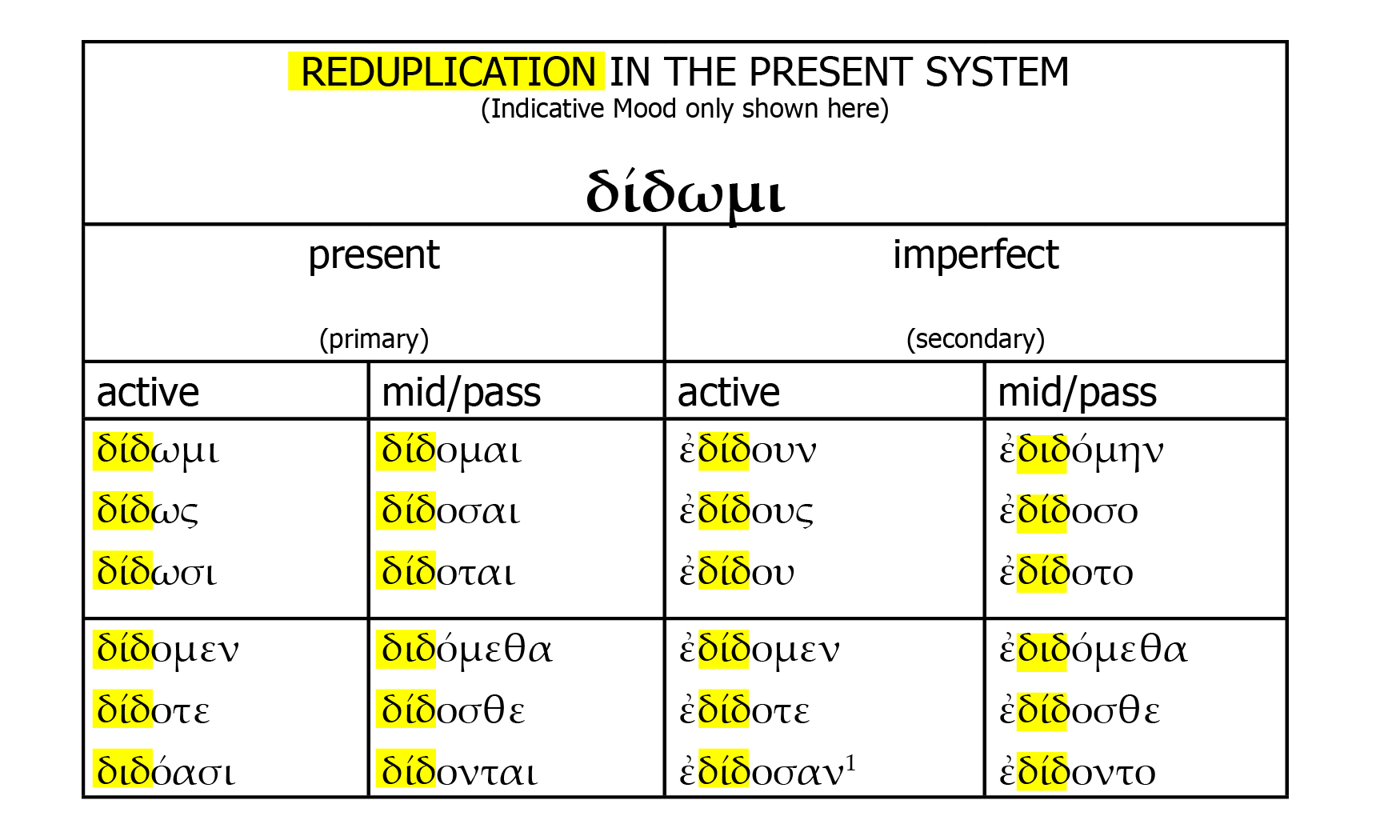
Again note that this only occurs in the present system. Perfect tense μι verbs have exactly the same characteristics as perfect tense ω verbs, reduplicating initial consonants and adding ε.
- LENGTHENED FINAL STEM VOWEL in PRESENT ACTIVE In the present active the final stem vowel is lengthened, but only in the singular.
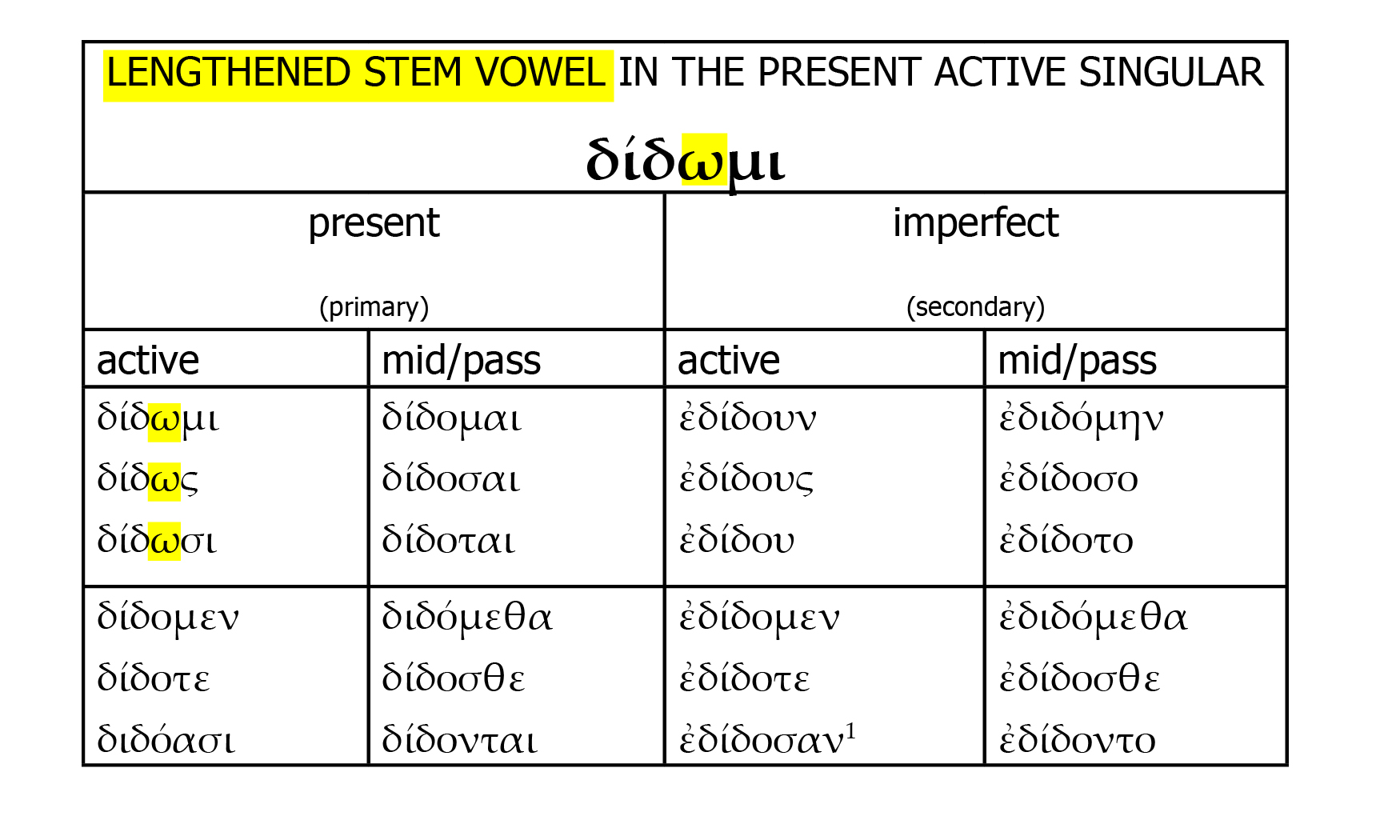
- LENGTHENED FINAL STEM VOWEL in IMPERFECT SINGULAR In the imperfect active indicative, the final stem vowel is lengthened, but only in the singular, and not always as you might expect. In the case of δο-, the οlengthens to ου.
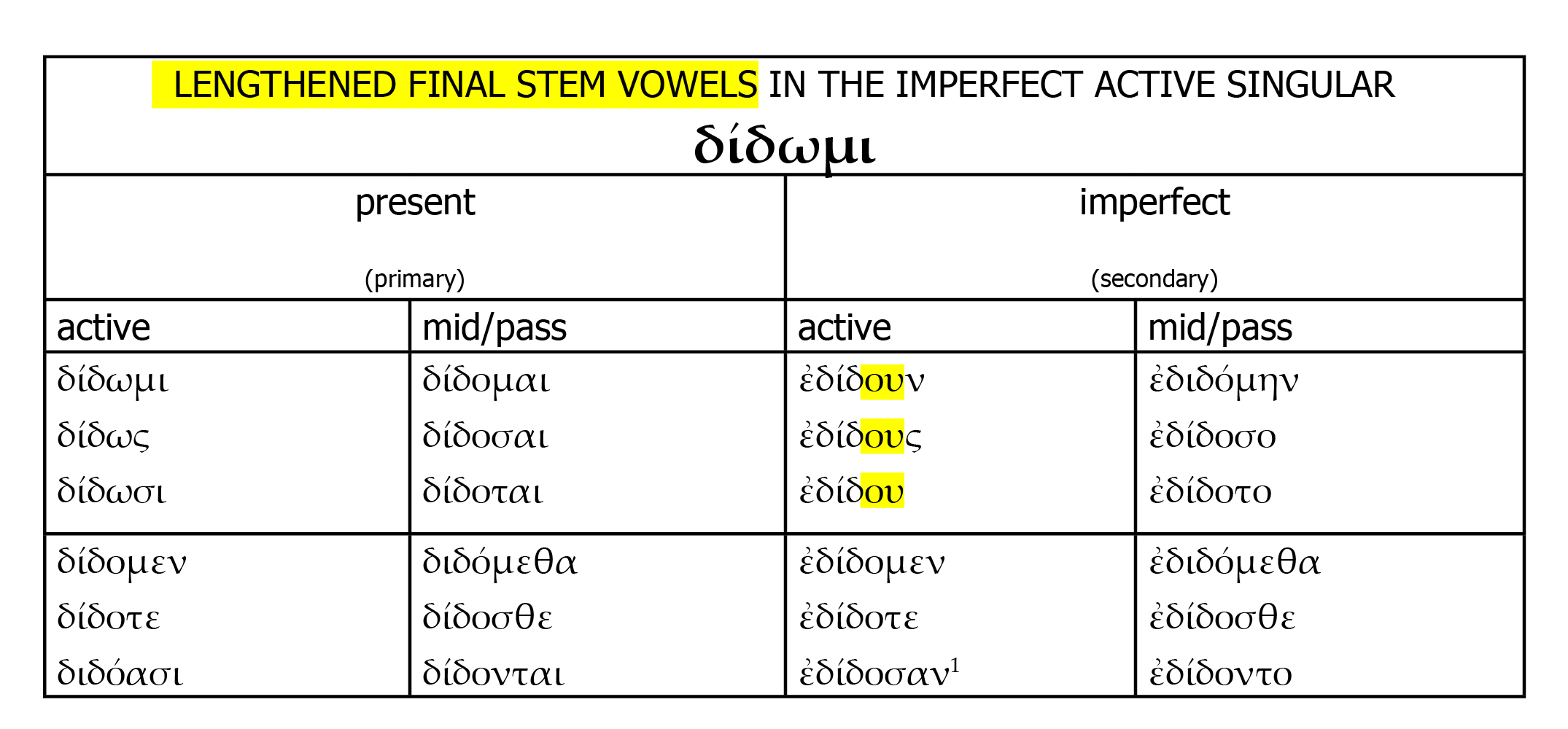
1 Notice that the imperfect active indicative 3rd person plural has σαν instead ν . But see Mark 3:6 where ἐδίδουν occurs.
- LENGTHENED FINAL STEM VOWEL IN FUTURE ACTIVE AND MIDDLE AND IN AORIST ACTIVE This will not look so strange because you have already learned to expect the final stem vowel of contract verbs to lengthen before the σ of the future and aorist.
- UNCONTRACTED 2nd PERSON SINGULAR in MIDDLE VOICE When the primary middle σαι and secondary middle σο are attached to stems of the present tense and imperfect tense respectively, the σ does not drop out and therefore there is no contraction such as we often see in the ω conjugation.
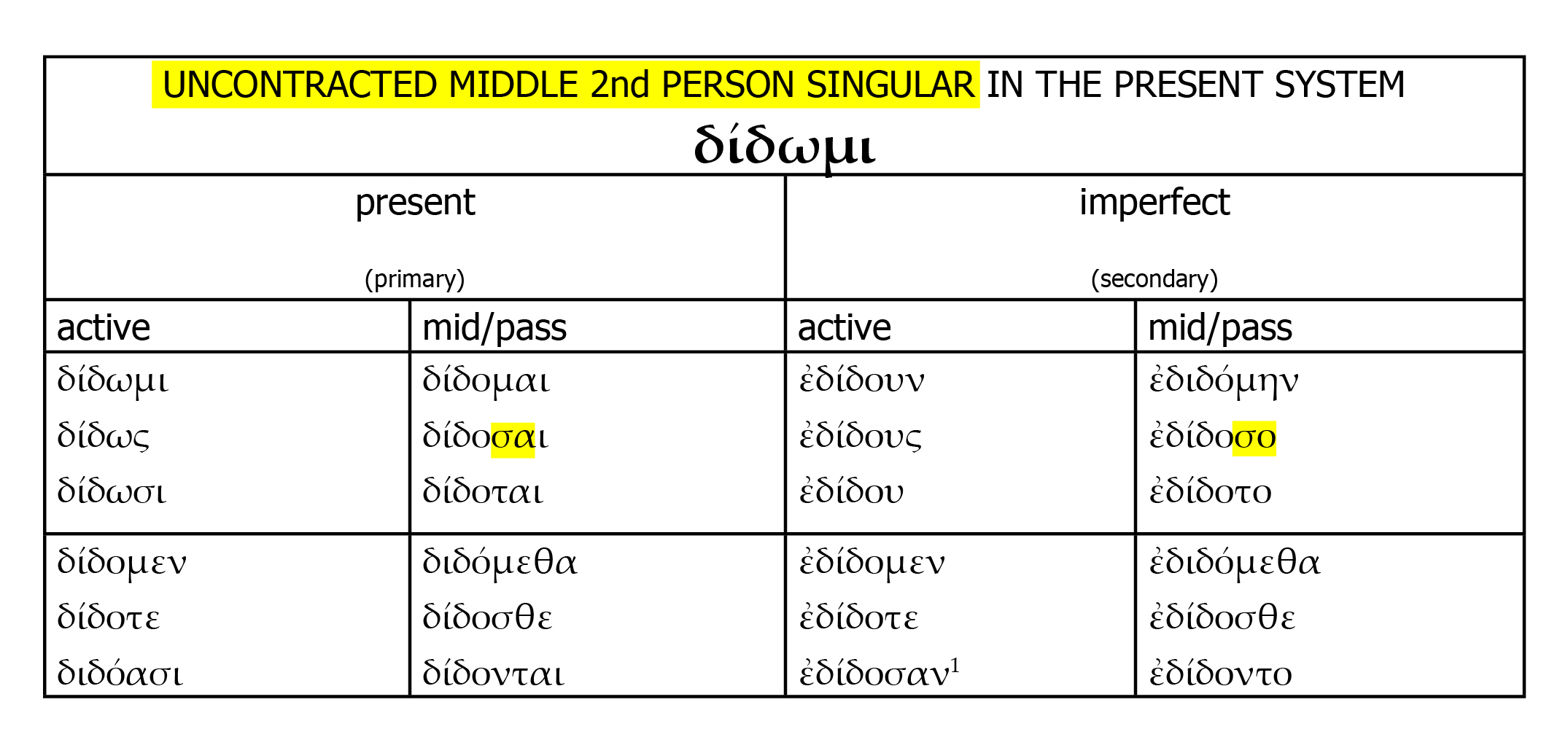
- 1st AORIST ACTIVE δίδωμι and τίθημι have κ instead of σ Also notice the lengthening of the final stem vowel in the active voice of the aorist tense.
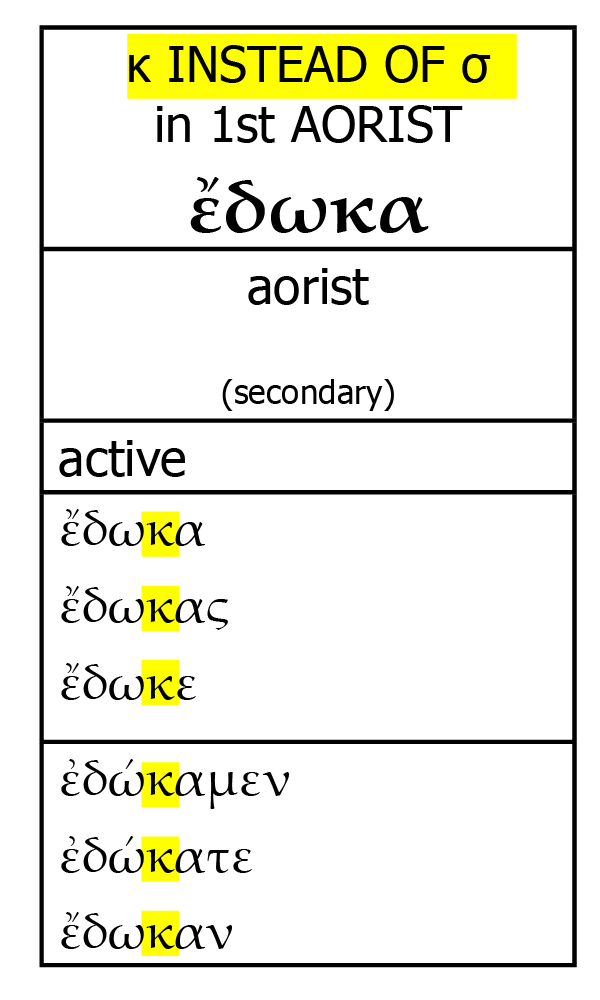
All of that may seem confusing, but when all is said and done, the new μι verbs you will most often encounter will either have the unusual reduplication with ι in which case you will say “μι verb!”, or the grammatical form will be easily recognized based on the rules you already know for the ω conjugation.
δίδωμι and Compounds
The following verbs in the NT are from the root δο-
δίδωμι, give
ἀνταποδίδωμι, give back, repay
ἀποδίδωμι, give away, give up
ἐκδίδωμι, let out for hire
παραδίδωμι, hand over, deliver
Indicative Mood
The forms in boldface are attested for δίδωμι or one of its compounds either in the NT or in the LXX (incl. Apoc.). The forms in gray are cited based on paradigms in published grammars or based on mention in a lexicon.
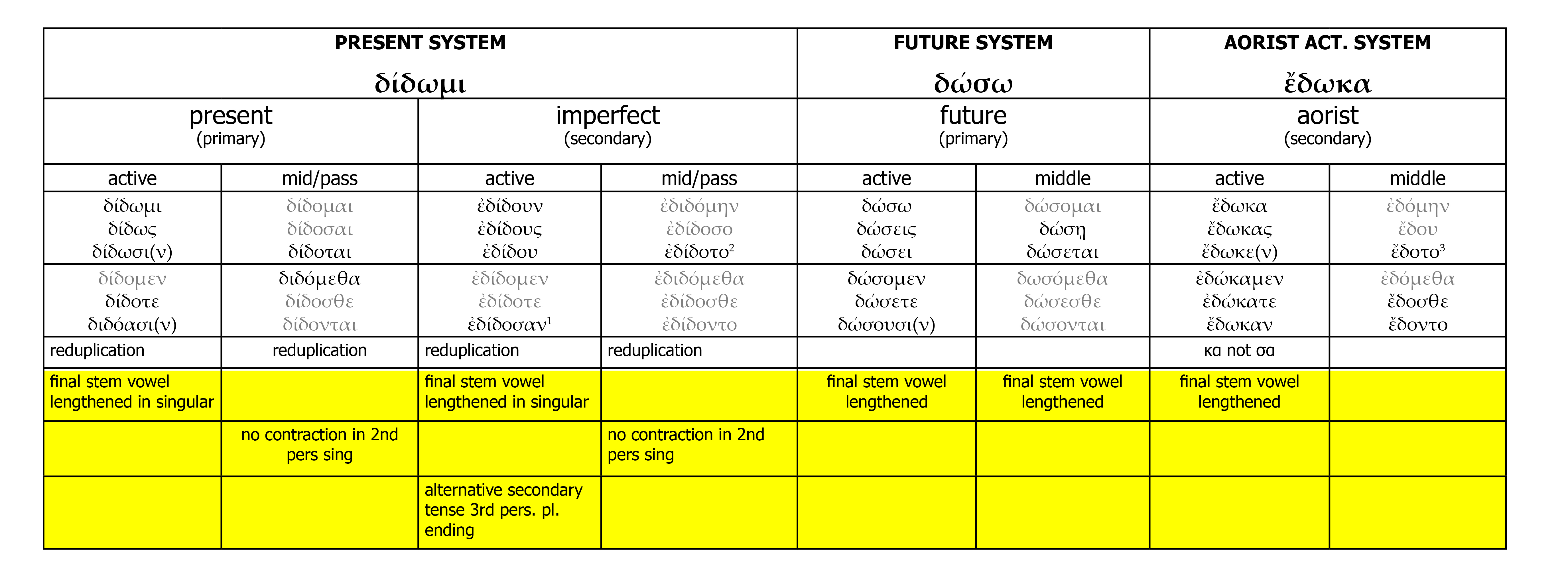
| 1 | But see Mark 3:6 where ἐδίδουν occurs |
| 2 | But -εδιδετο for -εδιδοτο in Ac 4:35 (διεδίδετο), 1 Cor. 11:23 (παρεδίδετο) |
| 3 | But -εδετο for -εδοτο in Hellenistic according to Zerwick/Grosvenor (An Analysis of the Greek New Testament, vol. 2, p. 686); see ἀπέδετο in Heb. 12:16, ἐξέδετο in Mt 21:33, Mk 12:1, Lk 20:9 |

ἵστημι
ἵστημι requires special attention. It has both 1st aorist and 2nd aorist forms. As a rule, the difference between a 1st aorist and a 2nd aorist is one of form, not function. But for ἵστημι, in the active voice there is a difference in meaning between the two aorist forms.
The basic meaning of the root στα- is stand. In English, one may stand a ladder up against a house, or one may stand on ladder. This illustrates the transitive and intransitive meanings respectively. A transitive verb takes a direct object. An intransitive verb does not.
In the active voice, 1st aorist ἔστησα is transitive while 2nd aorist ἔστην is intransitive. Compare the use of the 1st aorist 3rd person ἔστησε and the 2nd aorist 3rd person ἔστη in the following passages:
| transitive 1st aorist | intransitive 2nd aorist |
| καὶ προσκαλεσάμενος [having called to himself] παιδίον ἔστησεν αὐτὸ ἐν μέσῳ αὐτῶν (Mt. 18:2) | αὐτὸς ἔστη ἐν μέσῳ αὐτῶν καὶ λέγει αὐτοῖς, εἰρήνη ὑμῖν (Lk. 24:36) |
| Jesus “stood him in the midst of them.” | Jesus “himself stood in the midst of them.” |
